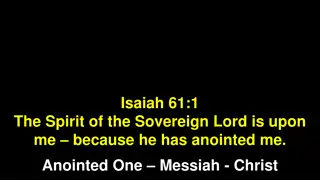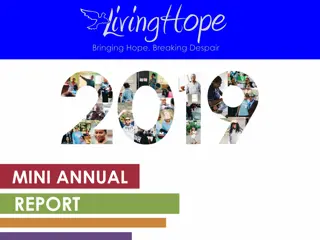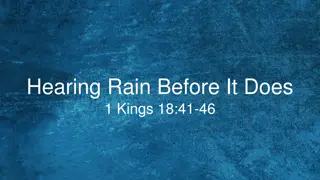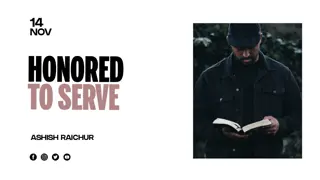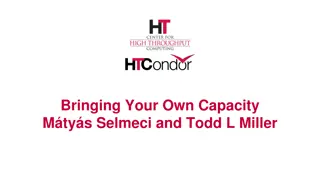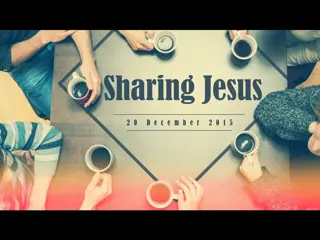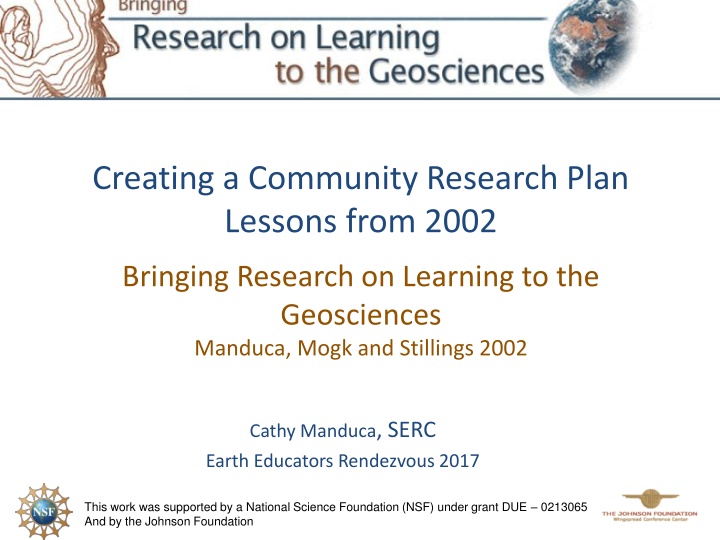
Connecting Geoscience Learning Research: Lessons and Opportunities
Explore how the integration of learning research into geoscience can benefit educators and researchers. This community research plan, based on findings from 2002-2017, emphasizes building connections, developing interest, and disseminating valuable insights within the geoscience education community. Key findings stress the importance of collaborative efforts, capacity building, and practical application of research.
Download Presentation

Please find below an Image/Link to download the presentation.
The content on the website is provided AS IS for your information and personal use only. It may not be sold, licensed, or shared on other websites without obtaining consent from the author. If you encounter any issues during the download, it is possible that the publisher has removed the file from their server.
You are allowed to download the files provided on this website for personal or commercial use, subject to the condition that they are used lawfully. All files are the property of their respective owners.
The content on the website is provided AS IS for your information and personal use only. It may not be sold, licensed, or shared on other websites without obtaining consent from the author.
E N D
Presentation Transcript
Creating a Community Research Plan Lessons from 2002 Bringing Research on Learning to the Geosciences Manduca, Mogk and Stillings 2002 Cathy Manduca, SERC Earth Educators Rendezvous 2017 This work was supported by a National Science Foundation (NSF) under grant DUE 0213065 And by the Johnson Foundation
Establishing Context What do you hope to accomplish? Why is now the right time?
Why 2002? How People Learn (2000) Hake, 1998 Existing efforts Community call 2000 2017
To what end? Connect and expand GER research dramatically Bring learning research into use in geoscience 2000 2017
build connections between experts on learning and geoscience educators develop buy-in from geoscience educators and creators of educational resources on the value and applicability of research on learning develop interest in researchers on learning in exploring questions of high interest to geoscience educators disseminate research on learning and its effective application to the classroom within the geoscience education community https://serc.carleton.edu/research_on_learning/workshop02/motivation.html
Explore feasibility of developing a research project that engages geoscience faculty in obtaining and interpreting data addressing a learning question of high utility in informing geoscience educational practice. https://serc.carleton.edu/research_on_learning/workshop02/motivation.html
What Happened as a Result? 2000 2017 2004
Key Findings From Report Lots of mutual opportunity at intersection of geoscience and learning science Discovery must be coupled with bringing research into use Capacity building is necessary Coordinated effort among geoscience educators and learning scientists
Key Findings From Report Research strategy: Expertise: What is nature of geoscience expertise? Learning: What is path to expertise? Instruction: How does instruction support this learning?
Key Findings From Report Research strategy: Expertise What characterizes the thinking of an expert geoscientist? What important concepts and skills are essential? How do geoscientists understand the Earth system in the context of complex interactions? What are goals of geoscience education? Learning Instruction
Key Findings From Report Research strategy: Expertise Learning What are cognitive pathways to achieving this expertise? How does this fit in with more general developmental and learning progressions? Time, Complex Systems, Visualizing the Earth Instruction
Key Findings From Report Research strategy: Expertise Learning Instruction How should learning environments be developed to effectively support students achievement of geoscience expertise? Field experiences, work with geoscience data Assessments to understand the above
What Happened as a Result? Goals drive Outcomes Outcomes drive Impacts This work was supported by a National Science Foundation (NSF) under grant DUE 0213065 And by the Johnson Foundation
What Happened as a Result? Coordinated Effort Among Geoscientists and Learning Scientists Science of Geoscience Learning Proposal (~2005) Spatial Intelligence Learning Center (2006) 2000 2017
SILC Geo Research Agenda 2005 Presentation Focus on common visualizations Characterize expert perception Develop understanding and tests of student perception Develop and test materials that lead students from novice to expert perception Disseminate materials and results
What Happened as a Result? Capacity Building is Necessary Cutting Edge: Pedagogic Emerging Themes Teaching with Visualization 2003 to Teaching about Time 2012 2000 2017
What Happened as a Result? Discovery must be coupled with bringing into use 2000 2017 Lots of individual/research group publications
What Happened as a Result? a research project that engages geoscience faculty in obtaining and interpreting data addressing a learning question of high utility in informing geoscience educational practice. 2000 2017
What Didnt Happen as a Result? Emergence of GER as a field
Emergence of GER JGE NAGT GER Division GER Advanced Degree Programs This effort 29 Papers in Past Year 4 Papers in 1994 1 Paper in 1967 1994 1994 2017
What Didnt Happen as a Result? Emergence of GER as a field how important was the report vs the general times? relationship to GER Division? NSF funding initiatives or programs Guiding research agenda within GER
What does this mean for you? Publish in a journal or book series where people will look for it Website is a valuable archive and community tool






